Note to Reviewer - Cognitive Testing of Revised ATUS Lexicon
Note to Reviewer - ATUS Testing.docx
Cognitive and Psychological Research
Note to Reviewer - Cognitive Testing of Revised ATUS Lexicon
OMB: 1220-0141
NOTE TO THE REVIEWER OF:
|
OMB CLEARANCE #1220-0141 “Cognitive and Psychological Research” |
FROM: |
Bill Mockovak Survey Methodologist Office of Survey Methods Research
|
SUBJECT: |
Submission of Materials for Cognitive Testing of the Revised ATUS Lexicon
|
Please accept the enclosed materials for approval under the OMB clearance package 1220-0141, “Cognitive and Psychological Research.” In accordance with our agreement with OMB, we are submitting a brief description of the research, and the materials to be used in the research.
The maximum number of burden hours is estimated to be 283.
If there are any questions regarding this project, please contact Bill Mockovak at (202) 691-7414.
Attachments
1 - The complete, simplified ATUS lexicon
2 - 35 time-use activities that will be coded by participants
3 - Instructions for Amazon’s Mechanical Turk (MTurk) Participants
4 - Activities to be coded in Focused Navigation Testing
5 - Instructions for the MTurk Screening Survey
I. Introduction and Purpose
The American Time Use Survey (ATUS) has been conducted solely via Computer Assisted Telephone Interviewing (CATI) since the survey began in 2003. ATUS management is considering adding a self-administered, web-based collection tool such that the ATUS would become a mixed-mode, CATI and web-based survey. The ATUS’s reliance on CATI has become a liability in recent years, as people have become less willing to answer their phones and participate in phone-based interviews. Additionally, the COVID-19 pandemic demonstrated the risk associated with ATUS’s dependence on a centralized call center when it closed in mid-March 2020 and ATUS interviews ceased.
The ATUS sample is drawn from households that have completed Wave 8 of the Current Population Survey (CPS). A specific person within the retired CPS household is selected and this person is then assigned a day of the week for an ATUS interview. The core of the ATUS is a 24-hour diary in which interviewers use conversational interviewing methods to elicit information about the activities respondents did on the day before the interview, who they were with, and where they were.
Other time-use surveys around the world have experimented with the use of self-administered web-based diaries, and this option has appealed to certain cohorts of respondents, especially young adults and those who like the flexibility of responding on their own schedule. However, there are challenges unique to the self-administered mode. When describing what they did during the day, respondents could be given the option of entering open-ended descriptions of their activities or, when possible, selecting from a list of predefined activities/categories. Selecting from a list of predefined activities would ease reporting and reduce burden but runs the risk of introducing measurement bias if the list does not fully capture what respondents do and how they verbalize their activities.
The current ATUS Activity Coding Lexicon is a 3-tiered, time-use classification system with 17 first-tier categories and over 300 activity categories.1 Each of the first-tier categories has two additional levels of detail. Respondents' reported activities are assigned 6-digit activity codes based on this classification system. In the current use of CATI for data collection, interviewers identify some common activities as they are collected during the interview (for example, sleeping, personal care, working) but enter verbatim descriptions of less commonly occurring activities and assign codes to the activities after the interview has been completed.
The ATUS program recognizes that portions of the current coding system are detailed and complex and would be too burdensome for self-coding by untrained respondents. To address this issue, an effort is currently underway to simplify and streamline the lexicon and to revise or eliminate categories (codes) that are infrequently used or have proven to be of little analytical value to data users. The purpose of the research described in this clearance is to cognitively test the revised lexicon to determine how well it holds together conceptually and if additional steps need to be taken to simplify it. As testing progresses, it is likely that small changes will be made to the lexicon. For example, some existing categories may be renamed, whereas others might be consolidated or reordered. However, the scope of the content will remain the same.
II. Methodology
Participants for the proposed testing will be recruited through Amazon’s Mechanical Turk (MTurk)2 for both the navigation and card-sorting tasks. The various tests are listed below:
Test |
Purpose |
Navigation Test 1 |
How well does an alphabetical ordering of Tier 1 activities work? |
Navigation Test 2 |
How well does ordering Tier 1 activities by frequency of use work? |
Navigation Test 3 |
Focused test of select ATUS tier 1 categories |
Navigation Test 4 |
Impact of adding an “other” category to the Tier 1 categories |
Hybrid Card Sort 1 |
Determine how well exemplars fall into select Tier 1 categories |
Hybrid Card Sort 2 |
Determine how well exemplars fall into select Tier 1 categories |
The proposed tests are described in detail in following sections. Each of the tests described will use participants from Amazon’s Mechanical Turk (MTurk).
Screening Survey
To ensure that higher quality MTurk participants are recruited, SurveyMonkey will be used to conduct an initial 2-minute, online survey prior to each test that asks for age, current employment status, number of children under 16 living in the household, and an open-ended question asking for a description of the most recent task that participants completed on MTurk.
Results from this survey will be used to screen participants for the quality of their response. Only participants who have submitted quality data will be allowed to complete the next task, which will be either a navigation task or card-sorting task, depending on the test (see Attachment 5 for the screening instrument). We estimate that 163 people will need to be screened prior to each of the six tests to provide the 125 participants required for each test.
IIA. Navigation Test 1
1. Research Objective
Determine how well the simplified ATUS lexicon works for self-coding of time-use activities. An alphabetical ordering of Tier 1 activities will be used as shown in the Method section that follows.
2. Method
Navigation, or tree testing, will tell us how easily a general population can categorize common time-use activities using the revised ATUS lexicon. A tool called TreeJack will be used to run the navigation test.3 Correctly categorizing descriptions of how people use their time will be a critical step in the completion of a self-administered diary. Navigation testing will help answer the following three questions about the menu:
Do the categories make sense to people?
Is the content grouped logically?
Can people find the category they want easily and quickly? If not, why not? What is distracting or misleading them?
The Tier 1 codes of the revised lexicon are shown in the table below. The complete lexicon is shown in Attachment 1.
Time-use Activity |
Caring for and helping children |
Caring for and helping adults |
Cleaning and repair services for vehicles and the household |
Communications, not in-person (phone, video calls, messaging, e-mails, mail) |
Driving or other travel |
Eating and drinking |
Educational activities |
Household activities |
Haircuts, massages, manicures, or other personal services s |
Professional and medical services |
Religious and spiritual activities |
Shopping |
Sleeping and own personal care |
Socializing, relaxing, and leisure |
Sports, exercise, and recreation |
Using government services and participating in civic obligations |
Volunteering for an organization |
Working and related activities |
Attachment 2 lists the 35 time-use activities that will be coded by participants. These activities were selected to test the full lexicon.
3. Participants
125 participants will be recruited through Amazon’s Mechanical Turk (MTurk) service. A general audience of adults (18 or older) will be recruited.
4. Analysis of Navigation Task 1
The following measures will be used to evaluate results from the navigation testing:
Direct success. This measure is defined as users who read the task and select the right code without trying any incorrect categories.
Time required for direct success. This is defined as time elapsed from start to end of the task.
Indirect success. This is defined as users who try different branches within the tree before selecting the correct code.
Time required for indirect success. This is defined as time elapsed from start to end of the task.
Failure. This is defined as users who select the wrong code as the final answer.
Whether the user ever tried the correct Tier 1 category.
Whether the user selected the correct Tier 1 category but then selected an incorrect code.
Time required for failure. This is defined as time elapsed from start to end of the task.
Major Distractors. This identifies which incorrect Tier 1 codes were selected at the start of a task.
Skip. This is defined as a user who gives up on the task entirely.
5. Instructions
Instructions for the navigation task are shown in Attachment 3.
6. Burden and Costs for Navigation Test 1
As mentioned previously, past experience has shown us that poor quality responses can be a problem using MTurk participants. Therefore, an initial two-minute screening survey will be used to screen MTurk participants to see if they provide quality responses. Respondents to the screening survey will receive 20 cents (10 cents per minute) to complete the screening survey. Including MTurk’s administrative fee of 40%, the total cost per participant for the screening survey will be $0.28. Based on past experience, we estimate that we will need to screen about 163 people to obtain the 125 required for each study.
The actual navigation test is expected to take an average of 20 minutes to complete. MTurk participants will receive $3.00 for participating in this test (15 cents per minute to encourage greater effort). Since MTurk charges a commission fee of 40%, the cost per case for this test will be $4.20. The total cost per participant including the screening survey will be $4.48.
The costs and burden hours are summarized below:
Burden hours for screening survey = 5.4 hours
Burden hours for test = 41.7 hours.
Each MTurk participant will receive $3.00 for completing the navigation task and $0.20 for completing the screener ($3.20 total).
Total cost per participant = $4.48, including a 40% MTurk administrative fee
These costs per participant and burden hours apply to each of the four navigation tests and two card-sorting tasks since they were designed to take the same amount of time.
IIB. Navigation Test 2
1. Research Objective
Test 2 will investigate whether ordering the menu items by their actual frequency of use in the ATUS Survey results in better, the same, or worse performance compared to the alphabetical ordering used in Navigation Test 1.
2. Method
The Tier 1 codes of the revised lexicon ordered by reported frequency of use in the actual ATUS data are shown in the table below.
Activities Ordered by Frequency of Occurrence in ATUS |
Sleeping and own personal care |
Driving or other travel |
Socializing, relaxing, and leisure |
Household activities |
Eating and drinking |
Caring for and helping children |
Caring for and helping adults |
Working and related activities |
Shopping |
Sports, exercise, and recreation |
Communications, not in-person (phone, video calls, messaging, e-mails, mail) |
Religious and spiritual activities |
Volunteering for an organization |
Educational activities |
Professional and medical services |
Personal care services (this had previously been combined with the category above) |
Cleaning and repair services for vehicles and the household |
Using government services and participating in civic obligations |
3. Participants
125 participants will be recruited through Amazon’s Mechanical Turk (MTurk) service. A general audience of adults (18 or older) will be recruited.
4. Instructions
Instructions for this navigation task are shown in Attachment 3.
5. Analysis
The analytical approach described in Navigation Test 1 will be used.
6. Burden and Costs for Navigation Test 2
The same burden and cost estimates apply as for Navigation Test #1.
IIC. Navigation Test 3
1. Research Objective
The purpose of Navigation Test 3 is to focus on time-use activities that occur in a selected set of 2-digit categories. These categories are of special interest to ATUS staff so additional coding descriptions are used.
2. Method
The time-use activities that will be tested are shown in Attachment 4. In addition, 16 other time-use activities will be added based on results from Navigation Tests #1 and #2. The additional activities will allow us to retest different portions of the lexicon.
3. Analysis
The analytical approach described in Navigation Test 1 will be used.
4. Burden and Costs for Navigation Test 3
The same burden and cost estimates apply as for Navigation Test #1.
IID. Navigation Test 4
1. Research Objective
After determining which ordering of the lexicon’s Tier 1 categories works best (alphabetical vs. frequency), a final test will be conducted with the “other” category present at the Tier 1(2-digit level). This test should inform us if including an “other” category at this level affects accuracy.
22. Method
Attachment 2 lists the 35 time-use activities that will be coded by participants.
3. Analysis
The analytical approach described in Navigation Test 1 will be used. The analysis will also focus on which descriptions are assigned the “other” code. This will help identify time-use activities that participants have difficulty assigning codes using the current lexicon. We can also look at results for these more problematic descriptions from Navigation Tests 1 and 2 to find out how accurately these descriptions were coded in those tests.
4. Burden and Costs for Navigation Test 4
The burden and cost estimates are the same as for Test 1.
IIE. Hybrid Card Sorting Tests 1 and 2
1. Research Objective
Card sorting will help determine how well the revised lexicon captures a wide variety of time-use activities. Card sorting will also help identify areas of conceptual confusion, as well as new categories that might be needed.
2. Method
In a hybrid card sorting test, participants sort a list of activities into predefined categories and also have the option of creating and naming new categories if they believe the current set of categories is inadequate.
Because general testing guidelines suggest limiting the number of items to be sorted to between 30 and 60, two hybrid card sorting tests will be used to determine how well the current lexicon categories work. The time-use activities to be sorted will come from the revised coding lexicon (4- and 6-digit examples) as shown in Attachment 2.
3. Test 1 (54 activities)
Includes categories 1, 2, 3, and 4, 18
01 Sleeping and own personal care (5)
02 Household activities (12)
03 Caring for household children (10)
Caring for and helping household adults (4)
04 Caring for nonhousehold children (10)
Caring for nonhousehold adults (9)
14 Religious and spiritual activities (3)
18 Driving or other travel (1)
4. Test 2 (57 activities)
Includes categories 5, 6, 7, 8, 9, 10, 11, 12, 13, 16
05 Working and related activities (5)
06 Educational activities (6)
07 Shopping (3)
08 Using professional and personal care services (4)
09 Cleaning and repair services for vehicles and the household (1)
10 Using government services and participating in civic obligations (1)
11 Eating and drinking (1)
12 Socializing, relaxing, and leisure (14)
13 Sports, exercise, and recreation (12)
15 Volunteering for an organization (5)
16 Communications, not in-person (phone, video calls, messaging, and e-
mails) (5)
5. Analysis
Card sorting is useful for discovering how people expect to see information categorized and also how they differ in their understanding of different concepts. The results will help us answer the following questions:
Which time-use activities are misplaced or placed in newly created categories?
What logic do participants follow in any new categories they’ve created?
Which activities are consistently placed together in the correct category?
Which activities are never put together, and are thus considered conceptually different by all participants?
Do people suggest different labels for the categories?
6. Burden Hours and Costs for the Hybrid Card Sorting Task
The approach used for recruiting participants in the navigation tests will be used in both card-sorting tests. Therefore, the burden and cost estimates are the same as in the navigation tests.
III. Participants
125 participants will be recruited for each test through Amazon’s Mechanical Turk (MTurk) service. A general audience of adults (18 or older) will be recruited.
IV. Burden Hours
A total of 978 participants will be screened and 750 will complete a test. The screening survey is expected to take 2 minutes and follow-up tasks are expected to take an average of 20 minutes per respondent.
A summary of the various tests, maximum number of participants, and burden hours are listed below:
Test |
Purpose |
No. of Participants |
Minutes |
Burden Hours |
Screening Tests |
To determine eligibility for the tests below |
978 |
2 |
32.6 |
Navigation Test 1 |
How well does an alphabetical ordering of Tier 1 activities work? |
125 |
20 |
41.7 |
Navigation Test 2 |
How well does ordering Tier 1 activities by frequency of use work? |
125 |
20 |
41.7 |
Navigation Test 3 |
Focused test of select ATUS tier 1 categories |
125 |
20 |
41.7 |
Navigation Test 4 |
Impact of adding an “other” category to the Tier 1 categories |
125 |
20 |
41.7 |
Hybrid Card Sort 1 |
Determine how well exemplars fall into select Tier 1 categories |
125 |
20 |
41.7 |
Hybrid Card Sort 2 |
Determine how well exemplars fall into select Tier 1 categories |
125 |
20 |
41.7 |
|
Total |
978* |
|
282.8 |
*Participants for each test are a subset of those screened.
V. Payment to Respondents and Data Confidentiality
Payments to MTurk participants are summarized in the table below:
Test |
No. of Participants |
Payment to Participants |
Total, including MTurk admin fee |
Screening Survey (one for each test) |
978* |
$0.20 |
$0.28 |
Navigation Test 1 |
125 |
$3.00 |
$4.20 |
Navigation Test 2 |
125 |
$3.00 |
$4.20 |
Navigation Test 3 |
125 |
$3.00 |
$4.20 |
Navigation Test 4 |
125 |
$3.00 |
$4.20 |
Hybrid Card Sort 1 |
125 |
$3.00 |
$4.20 |
Hybrid Card Sort 2 |
125 |
$3.00 |
$4.20 |
|
Total = 750 |
|
|
*We estimate that 30% of the screened MTurk participants will be rejected
Participants will be informed of the OMB number and the voluntary nature of the study.
This voluntary study is being conducted by the Bureau of Labor Statistics under OMB No. 1220-0141 (Expiration Date: March 31, 2021). Without this currently approved number, we could not conduct this study. This study will take approximately 20 minutes to complete. The BLS cannot guarantee the protection of study responses and advises against the inclusion of sensitive personal information in any response. This study is being administered by MTurk and resides on a server outside of the BLS Domain. Your participation is voluntary, and you have the right to stop at any time.
Attachments
Attachment 1 – The complete simplified ATUS lexicon
Attachment 2 – 35 time use activities
Attachment 3 – Instructions for Participants
Attachment
4 – Activities to be coded for focused navigation
Attachment
5 - Instructions
for the MTurk Screening Survey
Attachment 1 – The complete, simplified ATUS lexicon
Sleeping or own personal care |
||||
Sleeping |
||||
Sleeplessness |
||||
Washing, dressing, or grooming oneself |
||||
Health-related self care |
||||
Personal, private activities |
||||
Household (things you do in and around your home) activities |
||||
Interior cleaning |
||||
Laundry, ironing, or mending textiles |
||||
Storing, moving, or unpacking items, including groceries |
||||
Food or drink preparation or presentation |
||||
Kitchen or food clean-up |
||||
Home decoration, maintenance, or repair |
||||
Lawn, garden, or houseplant care |
||||
Pet care including general care for animals or pets (not veterinary care) |
||||
Walking, exercising, or playing with animals |
||||
Vehicle, appliance, tool, or toy maintenance or setup |
||||
Household or personal organization, planning, or finances |
||||
Other household activities |
||||
Caring for or helping others |
||||
Caring for or helping children |
||||
|
||||
Reading to or with children |
||||
Playing or doing arts, crafts, or sports with children |
||||
Follow-up
Probe: -
Who live in your household -
Who do not live in your household |
||||
Supervising children (as a primary activity) |
||||
Attending children's events |
||||
Picking up or dropping off children |
||||
Activities related to children's education |
||||
Activities related to children's health |
||||
Other care for children
|
||||
Caring for or helping adults |
||||
|
||||
Follow-up
Probe: -
Who live in your household -
Who do not live in your household |
||||
Picking up or dropping off adults |
||||
Other caring or helping activities for adults |
||||
Animal or pet care assistance for adults |
||||
Vehicle or appliance maintenance or repair assistance for adults |
||||
Household or financial management assistance for adults |
||||
Picking up or dropping off adults |
||||
Other caring or helping activities for adults |
||||
Working or related activities |
||||
Working at main job |
||||
Working at other job |
||||
Making money at main job by providing a service or through hobbies or performances Taking breaks at work |
||||
Job searching or interviewing |
||||
Other work activities |
||||
Educational activities/Classes |
||||
Taking a class for a degree, certificate, or license |
||||
Taking a class for personal interest |
||||
Homework for a class for a degree, certificate, or license |
||||
Homework for a class for personal interest |
||||
Extracurricular school activities (except sports) |
||||
Other educational activities |
||||
Shopping |
||||
Grocery shopping |
||||
Purchasing prepared food (not groceries) |
||||
Other shopping |
||||
Medical services or professional services |
||||
Banking, financial consultations |
||||
Medical appointments or consultations |
||||
Real estate, veterinary, or other professional services |
||||
Haircuts, massages, manicures, or other personal services |
||||
Haircuts Massages Manicures/pedicures Other personal services |
||||
Cleaning or repair services for vehicles or the home |
||||
Using government services or voting |
||||
Using government services |
||||
Voting |
||||
Other civic obligations |
||||
Eating or drinking |
||||
Storing, moving, or unpacking items, including groceries |
||||
Food or drink preparation or presentation |
||||
Kitchen or food clean-up |
||||
Socializing, relaxing, or leisure |
||||
Eating or drinking |
||||
Socializing or communicating for leisure (in person) |
||||
Attending or hosting parties, receptions, or ceremonies |
||||
Relaxing, thinking, taking breaks |
||||
Watching TV, movies, videos |
||||
Listening to radio, podcasts, music |
||||
Playing musical instruments, singing |
||||
Playing video games |
||||
Playing other games |
||||
Using social media (Facebook, Twitter, Instagram, etc.) |
||||
Using a computer—other uses; not for TV, games, reading, social media |
||||
Arts and crafts as a hobby |
||||
Reading for personal interest, listening to audiobooks |
||||
Attending movies, performing arts, zoos, museums |
||||
Other leisure |
||||
Exercise, sports, or recreation |
||||
Attending sports or recreation events |
||||
Bicycling |
||||
Golfing |
||||
Hiking, hunting, fishing, or other outdoor recreational activities |
||||
Playing basketball, soccer, or other team sports |
||||
Running |
||||
Swimming or other water sports |
||||
Walking for exercise Walking with animals/pets or playing with animals |
||||
Weight lifting, strength training |
||||
Yoga |
||||
Other exercise |
||||
Other sports |
||||
Religious or spiritual activities |
||||
Attending religious services |
||||
Religious or spiritual practices or education |
||||
Other religious or spiritual activities |
||||
Volunteering through an organization |
||||
Volunteering in administrative or support activities |
||||
Volunteering in social service or care activities |
||||
Volunteering in building, maintenance, or clean-up activities |
||||
Volunteering at performances or events |
||||
Other volunteering |
||||
Communications, not in-person (phone, video calls, messaging, e-mails, mail) |
||||
With friends or family |
||||
With others |
||||
Driving or other travel |
Attachment 2 - 35 time-use activities that will be coded by participants
Took a nap (01)
Got dressed for work (01)
Vacuumed and dusted my apartment (02)
Cleaned up the kitchen after supper (02)
Gave my dog a bath (02)
Worked on my taxes (02)
Watched my kids on the playground (03)
Did arts and crafts with my kids (03)
Read books to my children (03)
Provided pills to my elderly mother who lives with us (03)
Cooking dinner for my elderly father who lives nearby (04)
Watched my friend's child (04)
Walked my friend's child to school (04)
Mowed my neighbor's lawn (04)
Repaired my cousin's toilet (04)
Teleworked for my primary job (05)
Out of personal interest, watched a video on how to program on YouTube (06)
Had my a guitar lesson (06)
Bought groceries (07)
Had an online doctor's appointment (08)
My dog had an appointment with the Vet (08)
Got my car inspected (annual inspection) (09)
Voted at my local school (10)
Ate dinner at a restaurant (11)
Watched a streaming movie (12)
Played online video games (12)
Read a book (12)
Took a walk (13)
Went for a jog (13)
Played basketball (13)
Did yoga (13)
Attended church (14)
Acted as a chaperone for my daughter's school trip (15)
Called my sister on the phone (16)
Texted a friend (16)
Attachment 3 – Instructions for Amazon’s Mechanical Turk (MTurk) Participants
1. Navigation Task
a. Recruitment criteria: This task is open to adults aged 18-65.
b. Description of Navigation Task on the MTurk Site: We are conducting this research to understand how people think about their use of time. You will read an activity and pick a category that best describes the activity from a list of categories. For example, an activity might be “dozed off for a few minutes” so a good category to select would be “Sleeping.” There are 35 items to assign to a list of categories.
This task is estimated to take about 20 minutes, and you will be paid $3 for completing it.
c. Keywords: Organizing or classifying information, navigation task, research
d. Instructions for the Navigation Task:
Welcome to this study, and thank you for agreeing to participate!
In this study, you will first read descriptions of how people spend their time. Then you will assign each activity to the best selection from a list (menu) of categories.
You will be presented with 35 activities. Classifying them shouldn't take longer than 20 minutes.
Our goal is to determine how well the list of categories covers typical activities that people do.
Your participation will also help us find out how people think about how they spend their time.
Find out how on the next page ...
e. How the Tasks Will Appear On the Optimal Workshop Website (TreeJack Tool)
There are multiple screens in the TreeJack testing tool. Some key screens are shown below. Since this is a free demo instrument, only three tasks could be included.
Welcome Screen
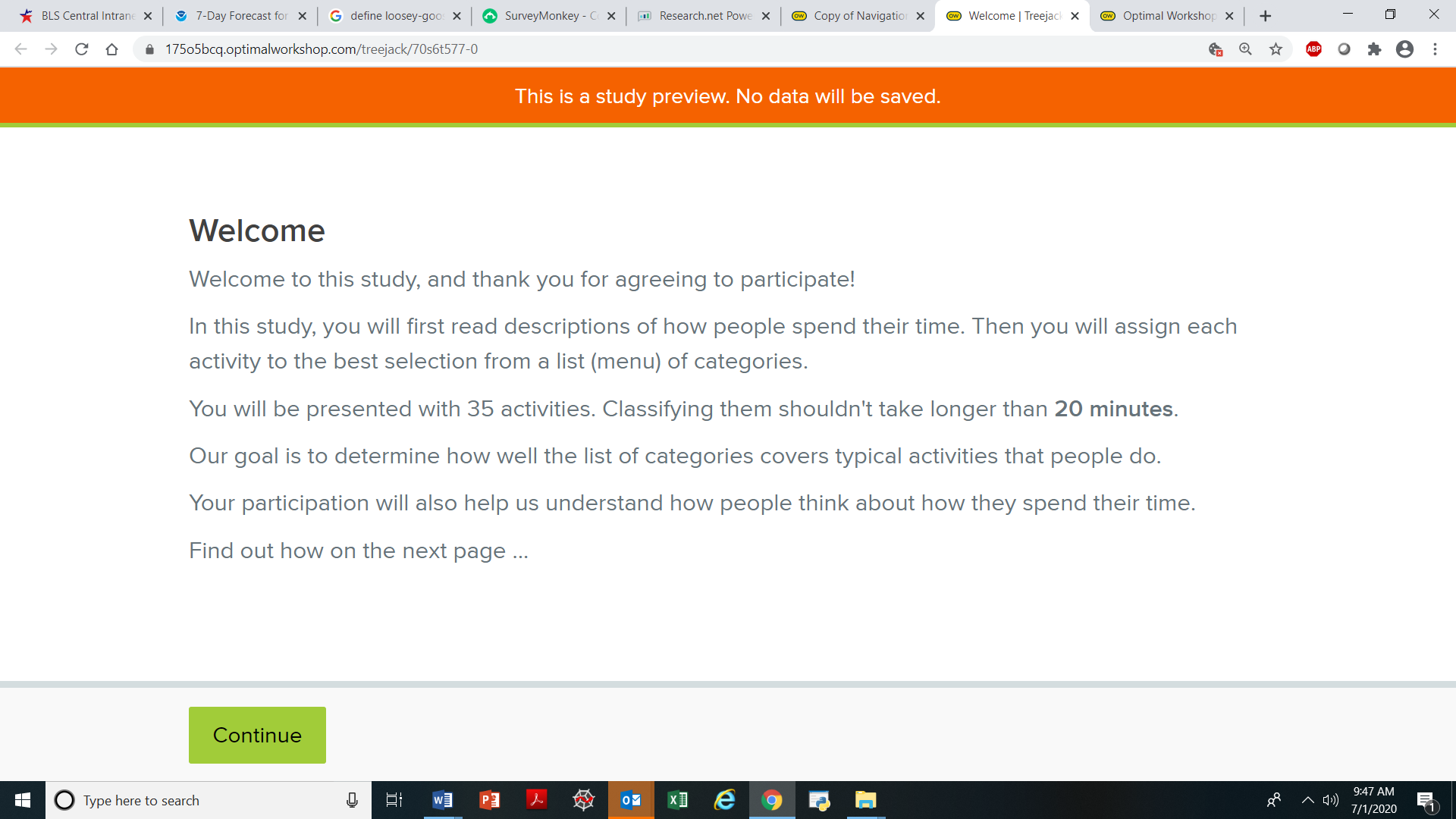
Instructions Screen
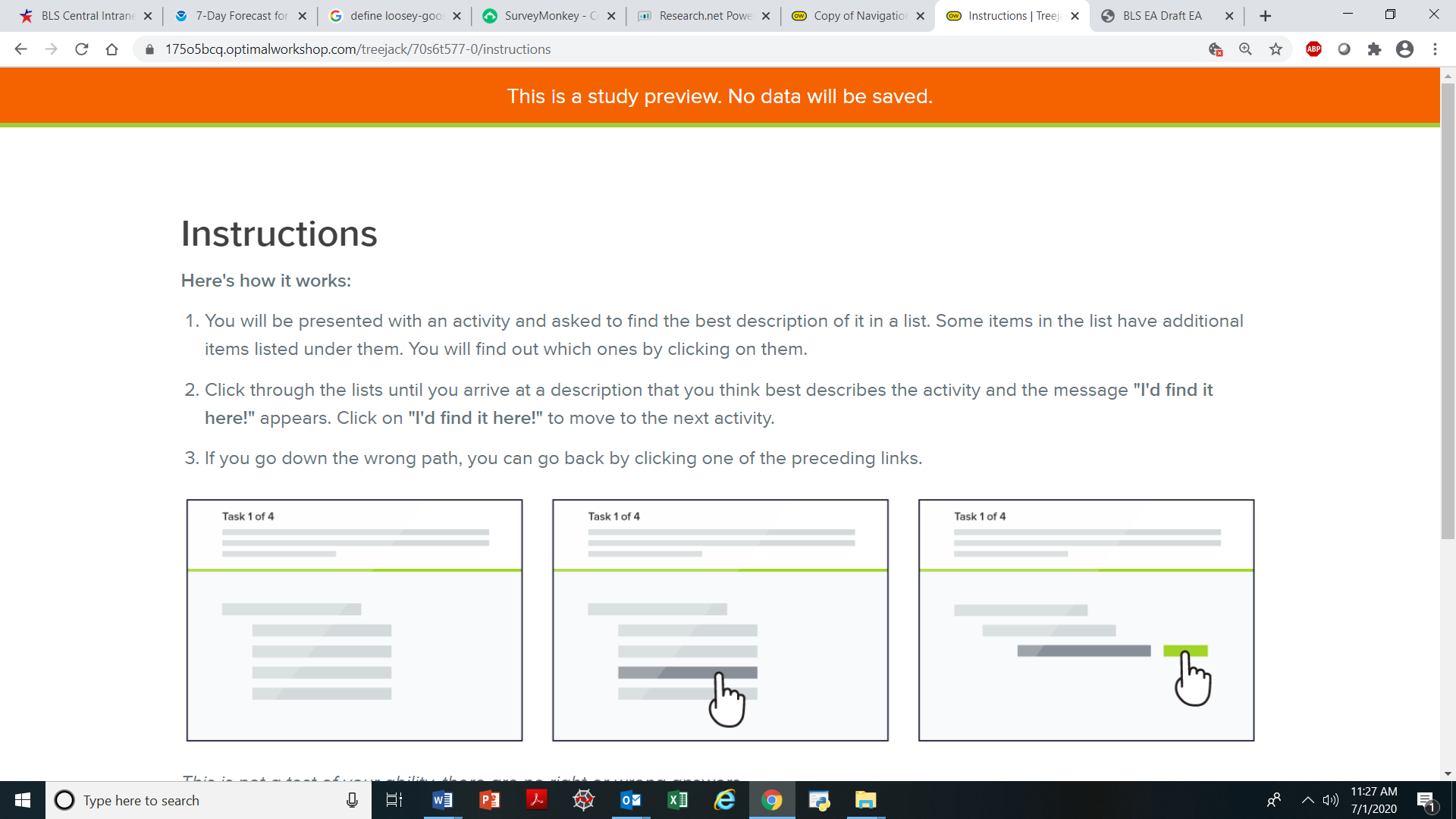
Task Screen
Each
task is shown here

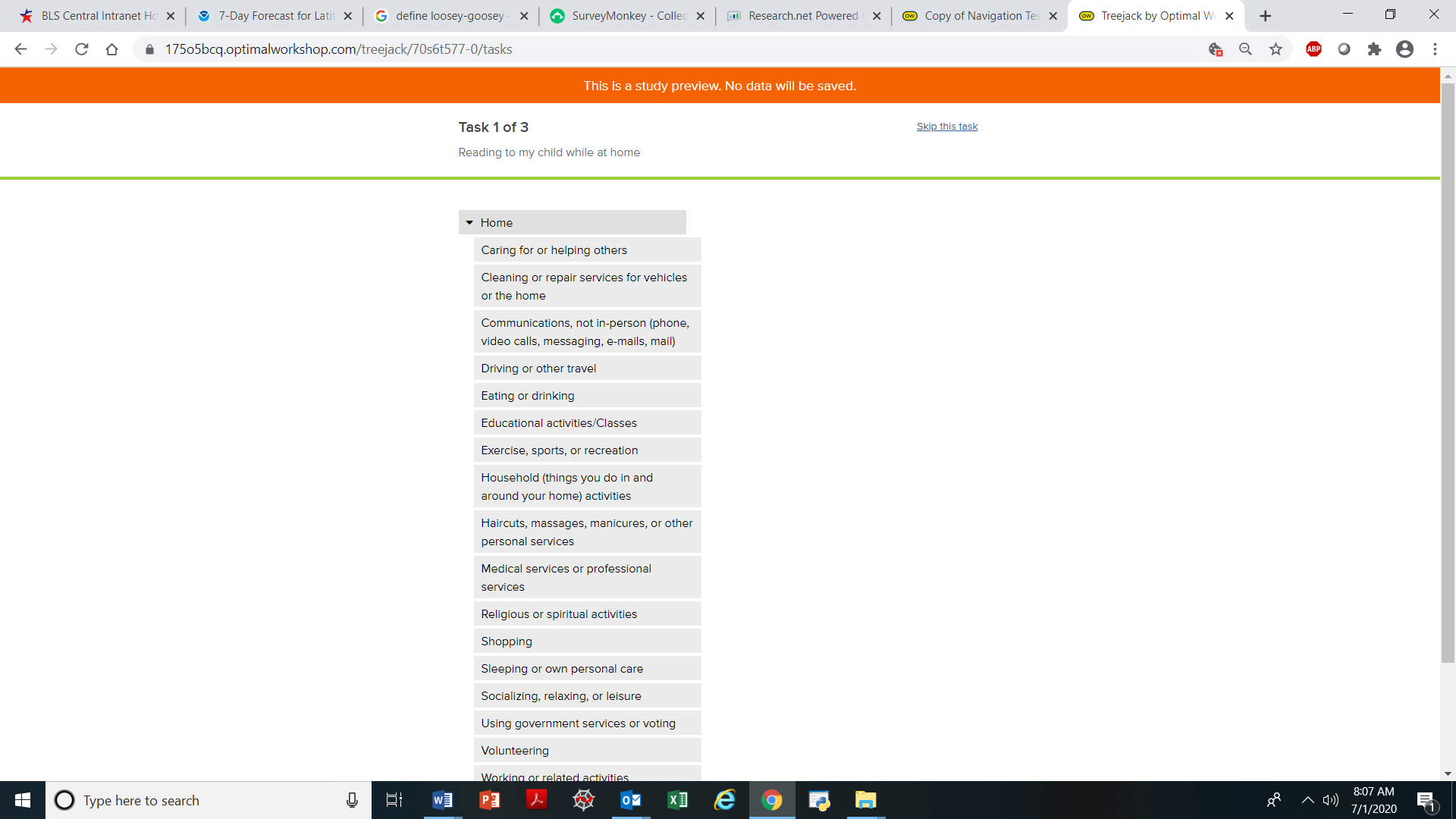
f. Actual menu that will be tested in Navigation Test #1
Cleaning or repair services for vehicles or the home
Communications, not in-person (phone, video calls, messaging, e-mails, mail)
Educational activities/Classes
Exercise, sports, or recreation
Household (things you do in and around your home) activities
Haircuts, massages, manicures, or other personal services
Medical services or professional services
Religious or spiritual activities
Socializing, relaxing, or leisure
Using government services or voting
2. Card Sorting Task - Instructions for the Card Sorting Task
a. Recruitment criteria: This task is open to adults aged 18-65.
b. Description of task on the MTurk Site: For some context, we are conducting this research as part of an effort to develop an online diary that captures how people use their time. In this task you will be asked to sort 35 activities that a person might have done during the day into some predefined categories. If you believe none of the existing categories are appropriate, you can create and name new categories.
This task is estimated to take about 20 minutes, and you will be paid $3 for completing it.
c. Keywords: Card sorting, sorting information, organization of information
d. Instructions for the Card-Sorting Task in the Optimal Workshop Card-Sorting Tool
Welcome Screen
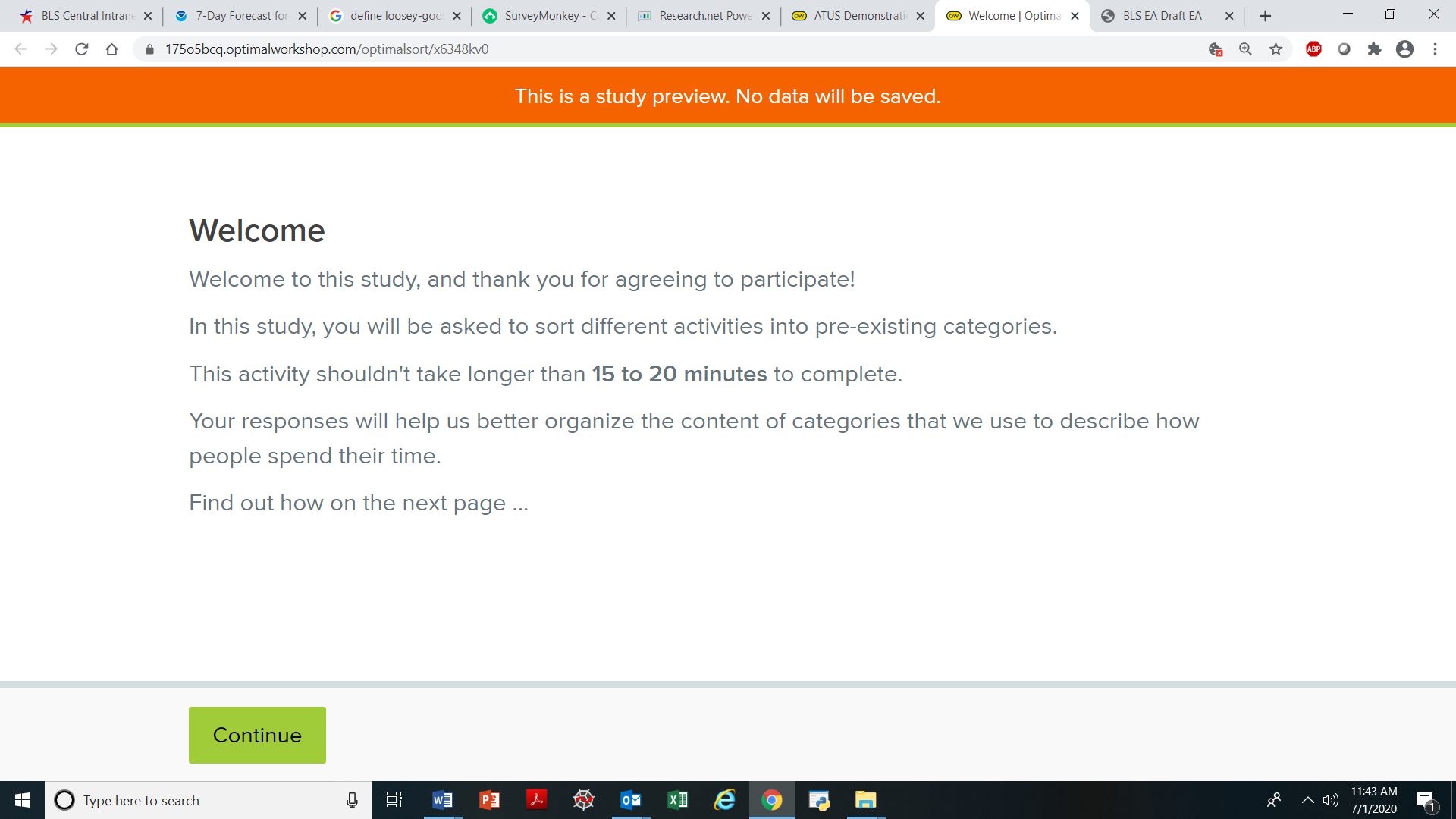
Instructions Screen
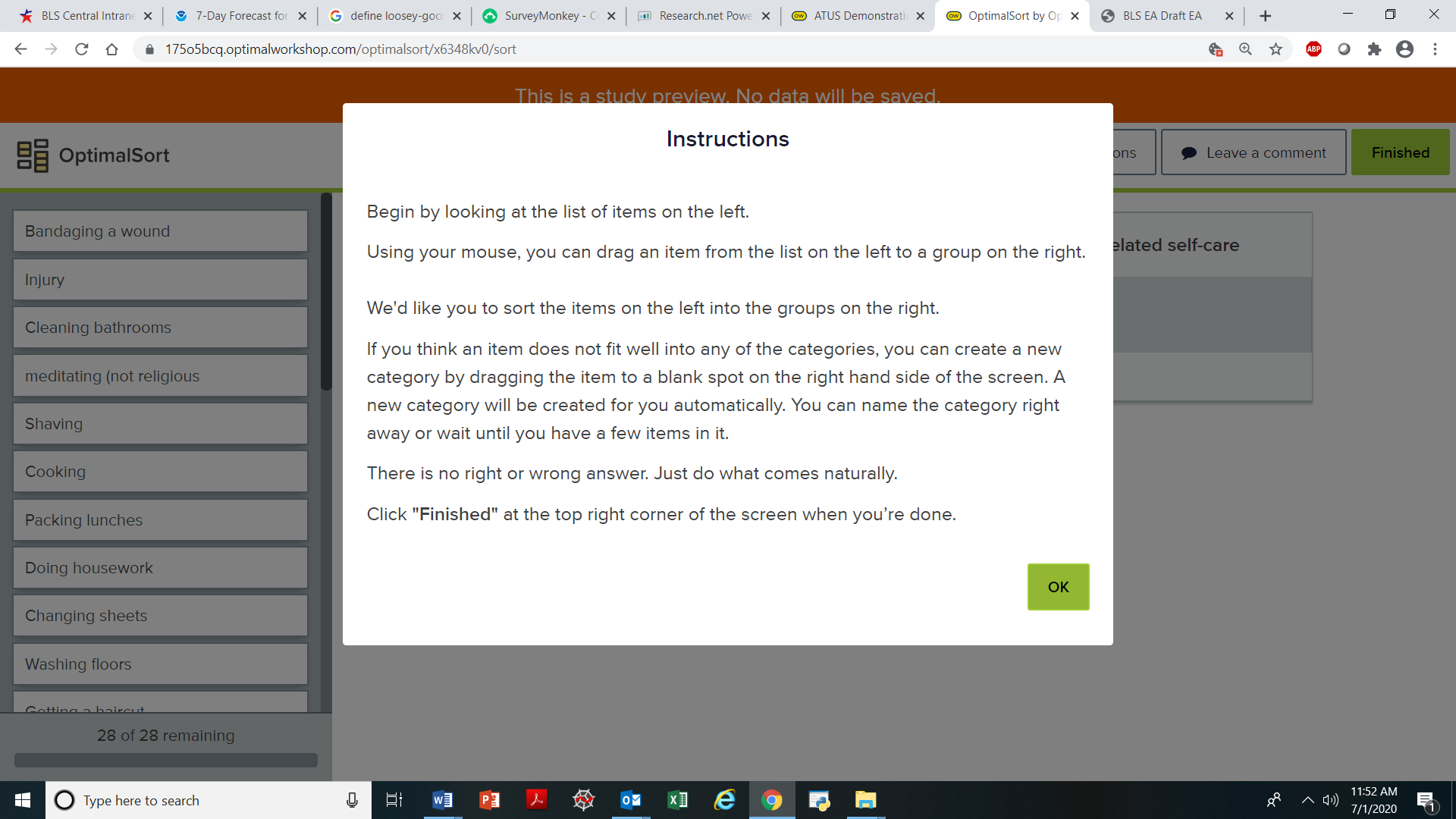
Initial Setup
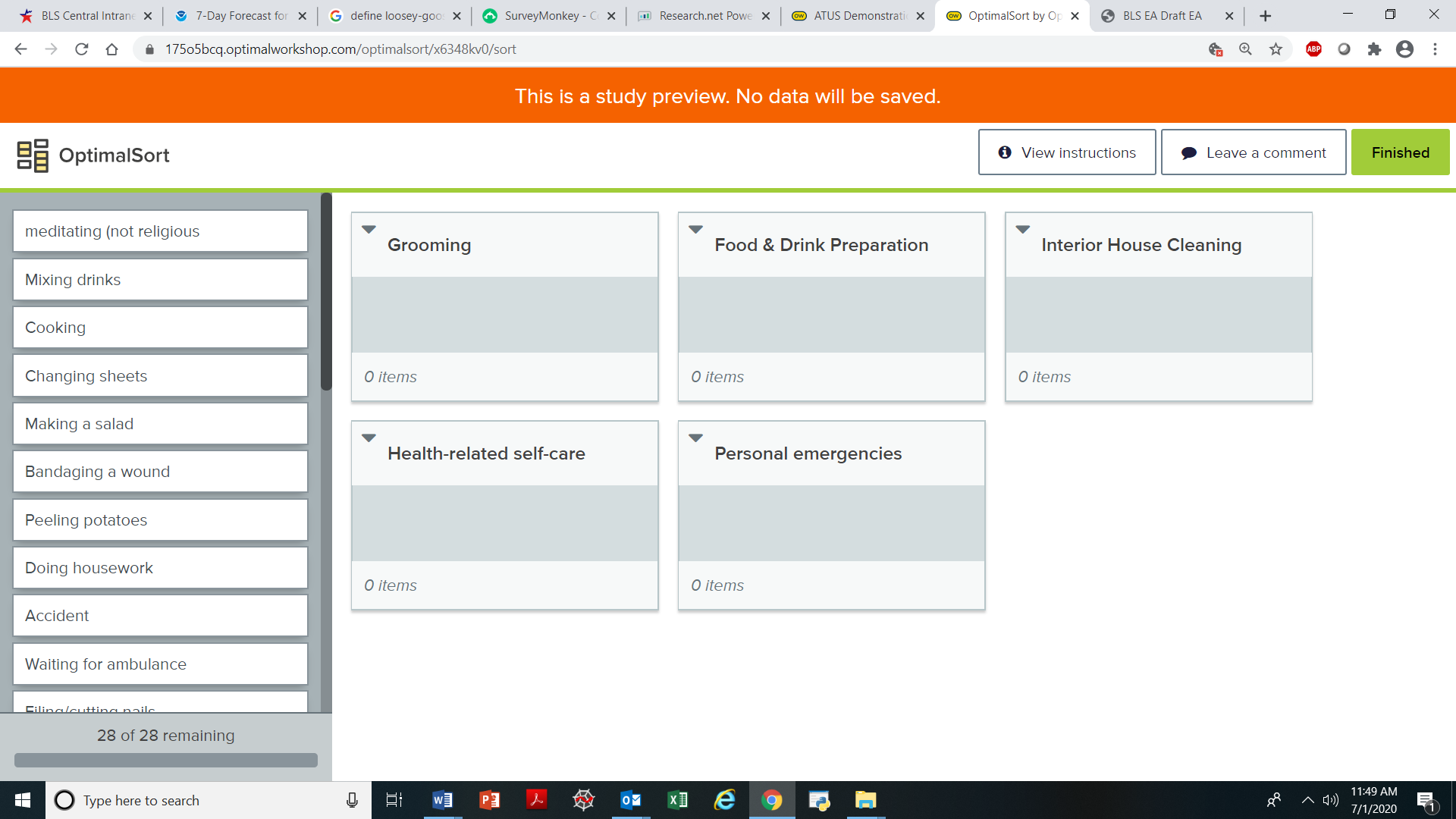
Attachment 4 – Activities to be coded in Focused Navigation Testing – The correct category is shown in parentheses (approximately 19 activities are shown. A similar 16 activities will be added depending on results from preceding navigation tests)
Attended an alcoholics anonymous meeting (01)
Attended a business meeting (05)
Got my car its annual inspection (09)
Met with the representative of a landscaping company to get an estimate for some work (09)
Voted at my local school (10)
Waited at motor vehicles to get plates for a used car purchase (10)
Read my daily newspaper (12)
Read an online blog (12)
Checked Facebook (12) - example of “using social media”
Read my Twitter feed (12) - example of “using social media”
Played a game of softball (13)
Went boating (13)
Went bowling (13)
Did step aerobics (13)
Wrote a letter to my grandmother (16)
Talked to my brother on the phone (16)
Sent emails to members of my book club (16)
Texted with my daughter (16)
Skyped (online video call) with my son who is overseas (16)
Attachment 5 – Instructions for the MTurk Screening Survey
a. Description of the Screening Survey on the MTurk Site:
You will be asked to complete a 2-minute survey to determine if you qualify for a follow-up study. You will be paid 20 cents for this 4-question survey.
b. Instructions and Questions in SurveyMonkey
The following screens show how the survey will appear in SurveyMonkey.
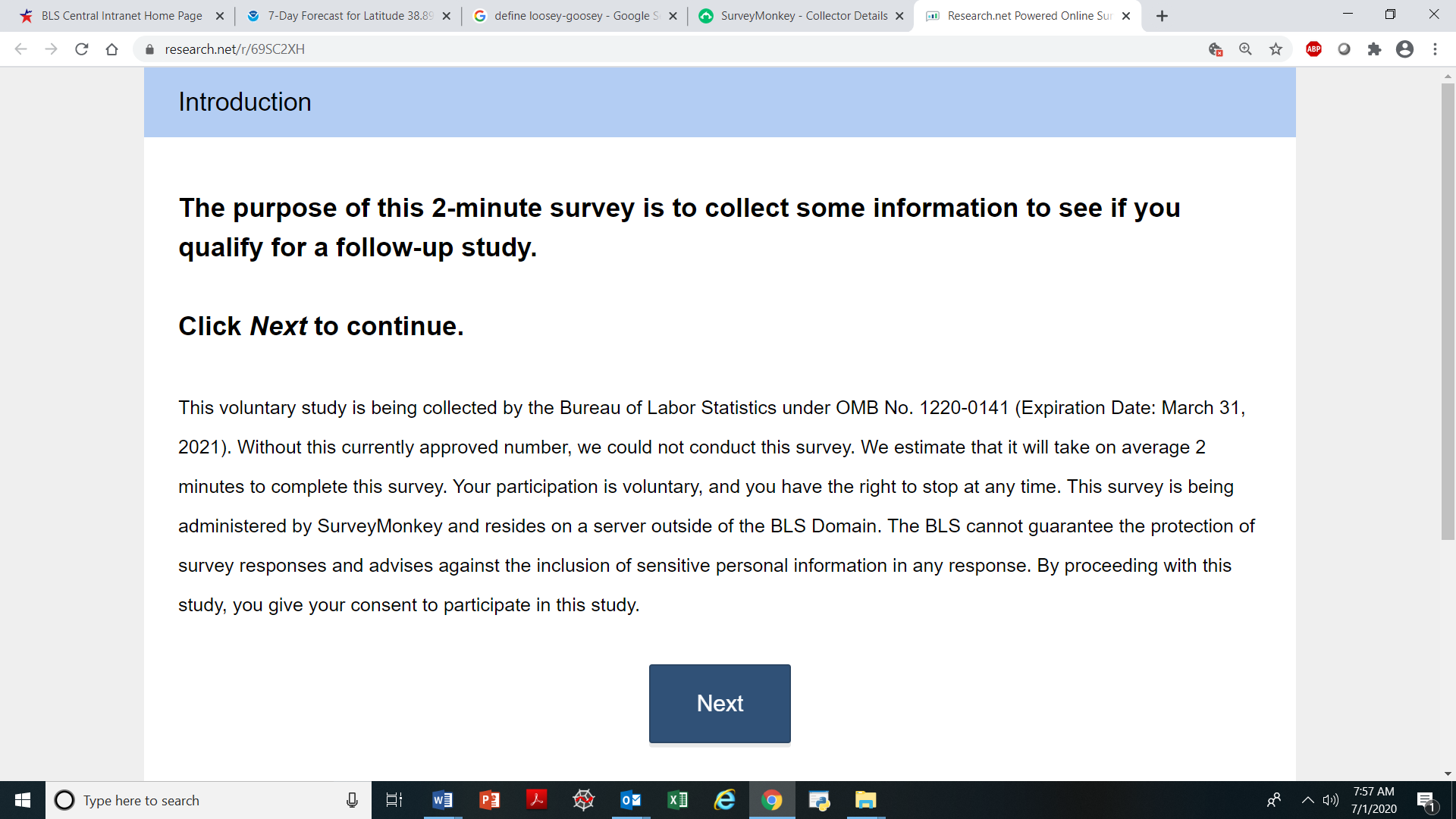
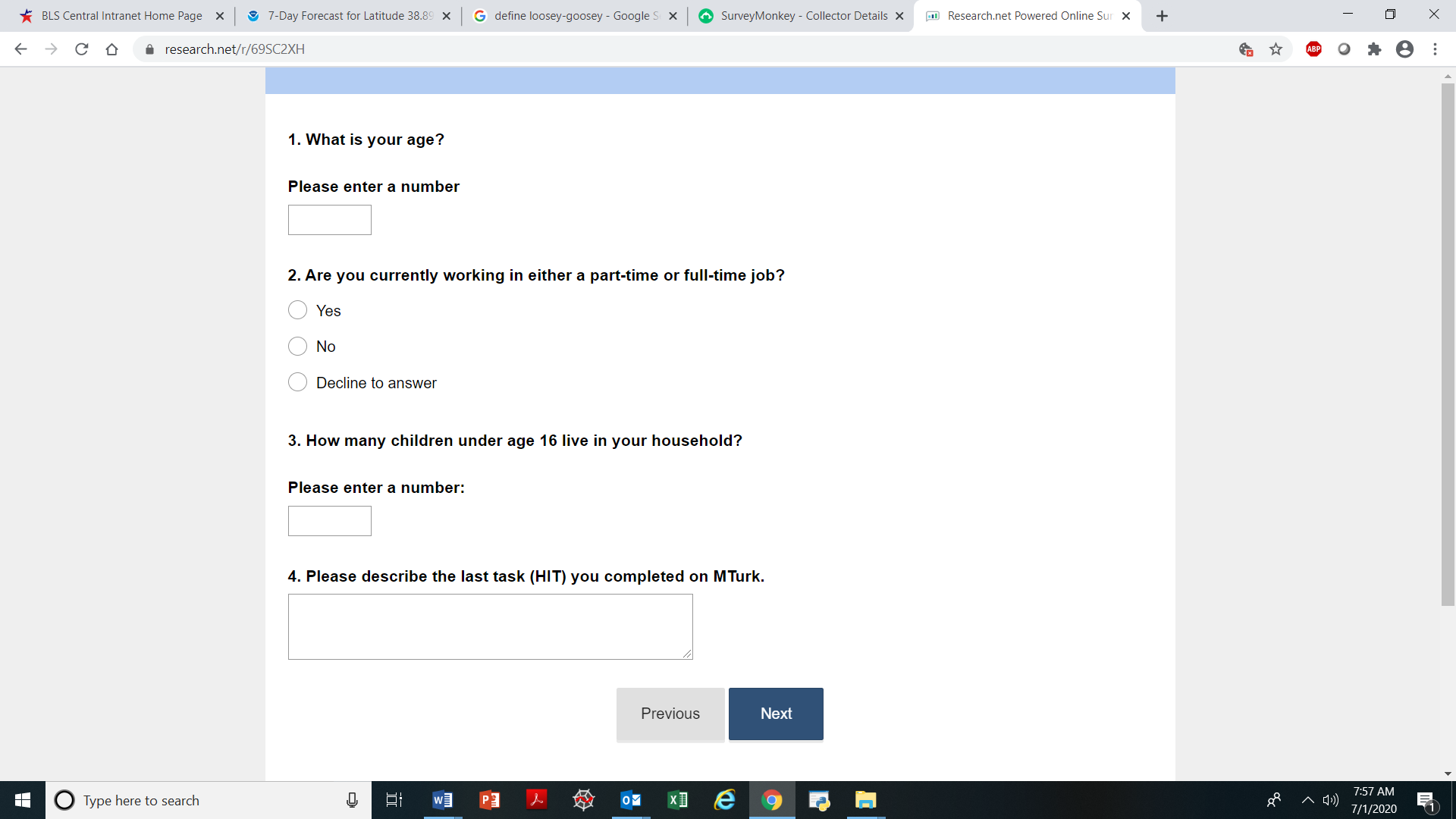
1 ATUS Lexicon: https://www.bls.gov/tus/lexicons.htm
| File Type | application/vnd.openxmlformats-officedocument.wordprocessingml.document |
| Author | Mockovak, William - BLS |
| File Modified | 0000-00-00 |
| File Created | 2021-01-13 |
© 2025 OMB.report | Privacy Policy
 Physical
care for children
Physical
care for children
 Physical
care for adults
Physical
care for adults